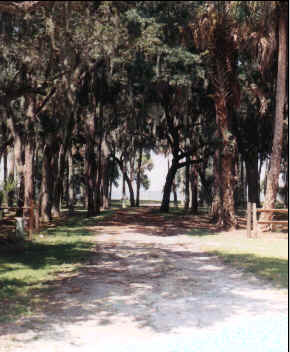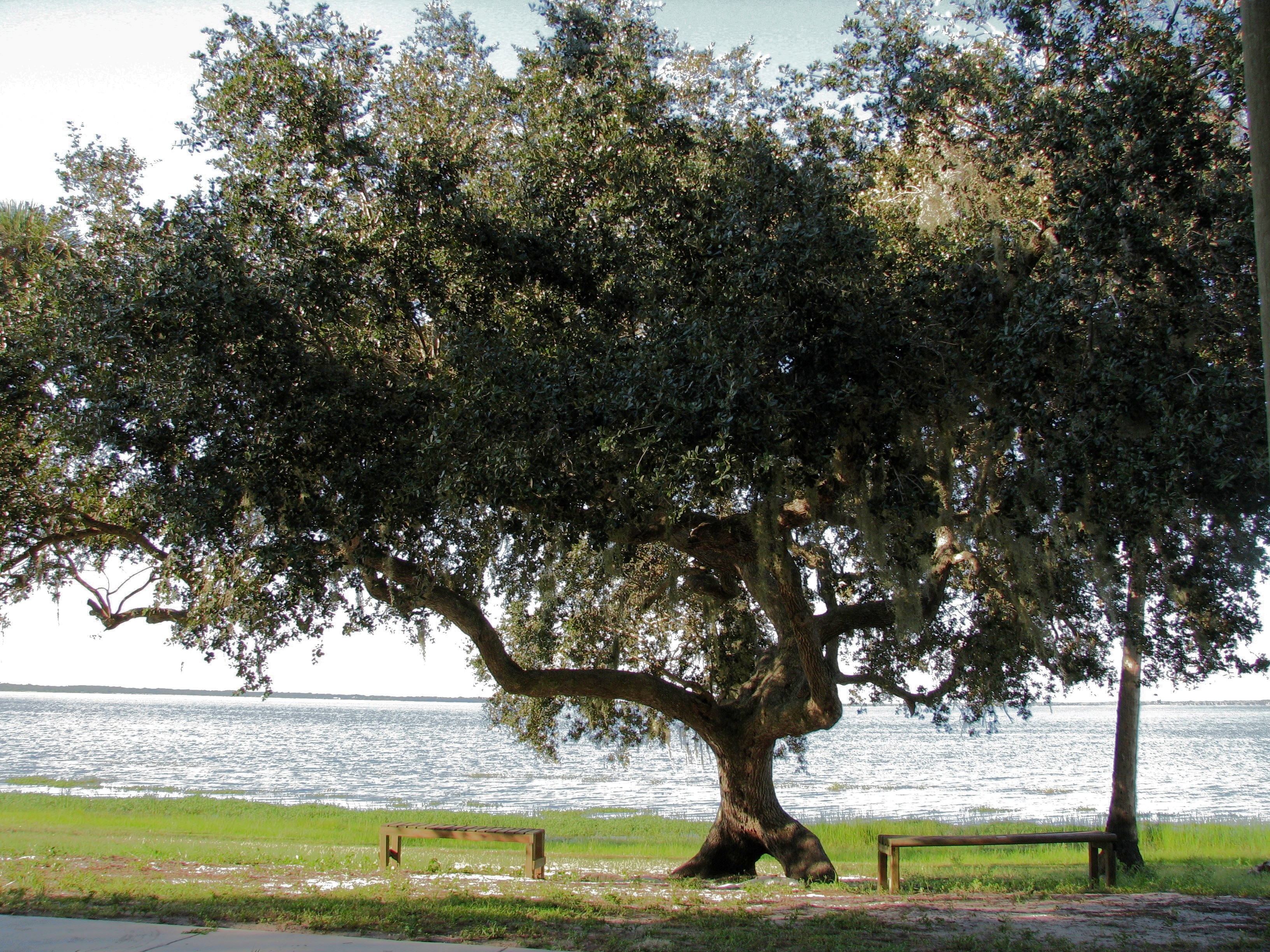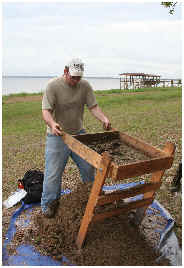Fort Lane Park
![]()
The Park
The area where "Fort Lane" was located is now Fort Lane Park, owned and operated by the Geneva Historical and Genealogical Society, Inc. A tract of land was donated in 1940 to the Seminole County Board of County Commissioners (BCC) to become a park. The Garden Clubs of Geneva & Sanford and the DAR agreed to help with the project. Then in 1962 the Geneva Historical Society requested and received the park from the BCC. It is supported only by donations of users and the money-raising projects of the Historical Society. This beautiful park overlooks Lake Harney and the St. Johns River and is open to everyone for public use.
The very first Seminole County Historical Marker was erected at the Fort Lane
Park. (See the history of the Fort below.) The
Sieg Pavilion, donated by the W. L. Sieg family, was dedicated in 1966, has a
view of the lake and is screened with picnic tables, refrigerator, and overhead
fans. There are also restrooms and picnic tables on the
grounds.
Fort
Lane Park is an ideal place for family
reunions, picnics, casual weddings, outdoor events, primitive
camping, etc. There is an outside fire ring for group campfires.
Swimming, boat launching, and alcohol are not
permitted in the park. A donation is expected for a reserved use of the
park. The pavilion can be reserved, or the park can be reserved for self-contained or
primitive camping, by calling
407-519-4033 or emailing:
FortLanePark@cfl.rr.com
Application/Info for Reservations
The park is open from sunrise to sunset and can be reached by traveling east on U.S. Hwy 46 from the traffic signal in Geneva, turning left (north) on Jungle Road, then right (east) on Fort Lane Road. The entrance is at the bend in the road. (See Covid-19 Waiver below.)
Covid-19 and Ft. Lane Park Use & Waiver
- - - - - - - - - - - - - - - - - - - - - - - - - - - - - - - - - - - - - -
Fort Lane Park Use - - - - -
COVID-19 WaiverNote that
any public location where people are present provides an inherent risk of
exposure to COVID – 19. The Geneva
Historical and Genealogical Society, Inc., CANNOT GUARANTEE that you or your
guests will not be exposed during your visit to Fort Lane Park. An
inherent risk of exposure to COVID-19 exists in any public place where people
are present. COVID -19 is an extremely contagious disease that can lead to
severe illness and death. By visiting Fort Lane Park, you voluntarily
assume for yourself and guests all risks related to exposure to COVID-19. You
are responsible for sanitizing all areas before and after use of the park and
facilities. All trash generated for
your event including disinfecting equipment and supplies must be removed from
the property.
All events
must stay within the Federal, State, and Local laws and guidelines that are in
effect at the time of the event, including social distancing and the number
allowed in a group.
By signing
this waiver you agree that you have read and understand the above conditions.
Applicant: ________________________________ Date: ________________
- - - - - - - - - - - - - - - - - - - - - - - - - - - - - - - - - - - - - -
History of the Fort
The Second Seminole Indian War, 1837-1842, was fought by the United States to drive the Seminole Indians from the peninsula of Florida. From his main base at Fort Mellon (Sanford) on Lake Monroe, General Jesup, Army of the South Commander, proposed to send an army of 2,000 men, under the command of General Eustis, to the head waters of the St. Johns River in pursuit of the southward retreating Seminoles. To support this army he established supply depots a day’s march apart (approximately 30 miles) along the proposed route.
 Fort Lane was the first depot in this chain. It was established on the west
shore of Lake Harney on 18 December 1837 by Companies "F" and
"K", 2nd United States Infantry, under the command of Major Greenleaf
Dearborn of Maine. Traveling by barges from Fort Mellon, the companies
consisted of an average of 125 Florida Militiamen, including a fifer and a
drummer, according to Army records (post returns). One of Jesup’s dispatches
from his fort was datelined "Headquarters, Army of the South, Fort Lane,
head of Lake Harney". Only three months later, the post returns indicate
that in March of 1838, having completed its assignment, the Fort Lane detachment
returned to Fort Mellon. Other officers at Fort Lane were Major Thomas Steniford, Lieutenant Silas
Casey, who was the adjutant, and Lieutenants J. R. D. Bennett, William Alburtis
and Hannibal Day.
Fort Lane was the first depot in this chain. It was established on the west
shore of Lake Harney on 18 December 1837 by Companies "F" and
"K", 2nd United States Infantry, under the command of Major Greenleaf
Dearborn of Maine. Traveling by barges from Fort Mellon, the companies
consisted of an average of 125 Florida Militiamen, including a fifer and a
drummer, according to Army records (post returns). One of Jesup’s dispatches
from his fort was datelined "Headquarters, Army of the South, Fort Lane,
head of Lake Harney". Only three months later, the post returns indicate
that in March of 1838, having completed its assignment, the Fort Lane detachment
returned to Fort Mellon. Other officers at Fort Lane were Major Thomas Steniford, Lieutenant Silas
Casey, who was the adjutant, and Lieutenants J. R. D. Bennett, William Alburtis
and Hannibal Day.
John Foote Lane, after whom the fort was named, was born in Kentucky on 21 December 1810. He was the youngest of 7 children born to Amos Lane and Mary Foote Lane. He entered West Point at age13 and graduated in 1828, when he was 18. An engineer and mathematician, Lane taught mathematics and philosophy at West Point for some time and is the inventor of the pontoon boat.
Lane was serving as a Captain in the United States Army 2nd Dragoon Regiment, when on 14 March 1836, he was promoted to Lieutenant Colonel and placed in command of the Creek Indian Regiment with 750 Creek Indians under his command. On 20 September 1836 he departed Alabama for Fort Drane, Florida (northwest of Ocala) with 690 Creek Indians and 90 soldiers for the purpose of engaging the Seminole Indians. Colonel Lane and his regiment arrived at Fort Drane in early October of 1836. Soon after arriving at Fort Drane, Colonel Lane came down with "brain fever" (encephalitis). He went insane, and on 19 October 1836, committed suicide by plunging his sword into his head.
 Fort Lane Archeological Survey
Fort Lane Archeological Survey
During the period of March 4-6, 2012, the Central Florida Anthropological Society conducted a Phase I survey at Fort Lane Park. The Historical Society contacted CFAS in 2010 and invited them to conduct the survey with the hopes of finding the exact location of the actual fort at Fort Lane Park.
Local University of Central Florida students, students from University of Florida, CFAS members, the Florida Historical Society and the Florida Public Archaeology Network were all on hand to conduct the survey over a period of 3 days. On Sunday we advertised a public day and invited the community to stop in and talk to the workers. Quite a few local townsfolk stopped in throughout the day, taking advantage of the chance to be entertained and enlightened about Florida archaeology.
CFAS will clean and categorize the artifacts retrieved from Fort Lane, write up a detailed report and then return the artifacts to the Geneva Historical Society for display as we see fit.
Kevin Gidusko who is heading up the
study, stated in an email to the GHGS:
I wanted to take the opportunity to thank you for
your hospitality and for the enthusiasm you have shown for the Fort Lane
project. I think I speak for all of us when I say it was one of the most
fun, most interesting, and most educational digs we've worked on. Not only
are we learning more about your park, local history, and eventually the grander
history of the St. Johns, but your invitation allowed us to provide hands-on
learning opportunities for local students the likes of which it is hard to get
without spending a few thousand dollars for a field school. These kinds of
opportunities are invaluable. Thank you!
While we set out to look for Fort Lane it appears
the project has veered a little further into the past. From our shovel
tests we actually recovered relatively little in the way of historical
artifacts. I believe a few nails is all. Still, what we did find is
in many ways just as exciting and ties into a history of the site that may be
hundreds or even thousands of years old. Now begins the task of cleaning
and analyzing the artifacts which I will be keeping you informed on.
Remember
that it is illegal to dig for artifacts without the landowner's permission. The
Historical Society must be contacted before any digging is done on Fort Lane or
Museum property. Digging for
artifacts on state lands without a permit from DHR is a third degree felony (Chapters
267.061 and 267.12-13,
Florida Statutes, and Rule 1A-32 of the Florida Administrative Code).
If you see looting or damage of archaeological sites, please notify the
Dave McDonald, 407-349-9876, or call local law enforcement.
http://centralflanthropologicalsociety.com/
References
Francke, Arthur E., Jr. Fort Mellon 1837-42. Banyan Books, Inc. Miami, FL. 1977.
Konstantin, Phil, September 16th to 22nd in American Indian History. 1997.
Return to Geneva History page.
Home
Page ![]() Genealogy
Genealogy ![]() The Society
The Society ![]() Museum
Museum ![]() Books, T-Shirts, etc.
Books, T-Shirts, etc.